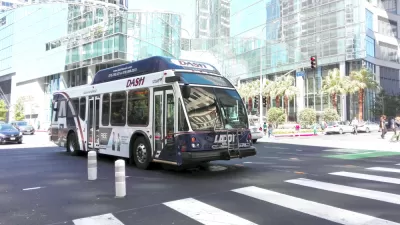What's it like to lead the department of transportation in a city trying to overcome decades of car-centric planning? Let LADOT General Manager Seleta Reynolds tell it in her own words.

Eddie Kim interviews Seleta Reynolds, the general manager of the city of Los Angeles' Department of Transportation, who was hired by mayor Eric Garcetti "with an eye toward finding ways to improve the city not just for drivers, but also for walkers, cyclists and transit users."
The interview begins with a discussion of the city bus service known as the DASH, which is close to completing a service expansion that keeps up with the changes in Downtown (such as the ongoing investment in the Arts District).
Also discussed in the interview is the city's Vision Zero initiative, announced in August 2015, and setting a target for zero traffic fatalities by 2025. To summarize the current state of the LADOT's efforts on the Vision Zero initiative, Reynolds explains the following:
We’re almost done with our crash profiling, where we identify high-injury networks — where we have the most severe crashes with people walking or biking. Now we’re doing the deep dive into “Why?” It’s kind of like archaeology: What can we learn from the crash reports that we get from the enforcement side of the department, and how do we layer that info on top of what we know about the physical environment?
Reynolds makes another telling point when comparing the political culture of the San Francisco area, where she worked previously in her career, with that of Los Angeles. According to Reynolds, Los Angeles lacks the robust public dialogue found farther north. "There needs to be a safe space for that to occur," says Reynolds. "Part of that is, my engineers and planners need to know that if they make a mistake while speaking, I have their back. But it’s a lot of work, and not everyone is comfortable with it. This can lead to a place where people hold their cards very tightly and not be open and honest."
FULL STORY: Chatting With L.A. Transportation Master Seleta Reynolds

Study: Maui’s Plan to Convert Vacation Rentals to Long-Term Housing Could Cause Nearly $1 Billion Economic Loss
The plan would reduce visitor accommodation by 25,% resulting in 1,900 jobs lost.

North Texas Transit Leaders Tout Benefits of TOD for Growing Region
At a summit focused on transit-oriented development, policymakers discussed how North Texas’ expanded light rail system can serve as a tool for economic growth.

Why Should We Subsidize Public Transportation?
Many public transit agencies face financial stress due to rising costs, declining fare revenue, and declining subsidies. Transit advocates must provide a strong business case for increasing public transit funding.

How to Make US Trains Faster
Changes to boarding platforms and a switch to electric trains could improve U.S. passenger rail service without the added cost of high-speed rail.

Columbia’s Revitalized ‘Loop’ Is a Hub for Local Entrepreneurs
A focus on small businesses is helping a commercial corridor in Columbia, Missouri thrive.

Invasive Insect Threatens Minnesota’s Ash Forests
The Emerald Ash Borer is a rapidly spreading invasive pest threatening Minnesota’s ash trees, and homeowners are encouraged to plant diverse replacement species, avoid moving ash firewood, and monitor for signs of infestation.
Urban Design for Planners 1: Software Tools
This six-course series explores essential urban design concepts using open source software and equips planners with the tools they need to participate fully in the urban design process.
Planning for Universal Design
Learn the tools for implementing Universal Design in planning regulations.
Ascent Environmental
Borough of Carlisle
Institute for Housing and Urban Development Studies (IHS)
City of Grandview
Harvard GSD Executive Education
Toledo-Lucas County Plan Commissions
Salt Lake City
NYU Wagner Graduate School of Public Service





























